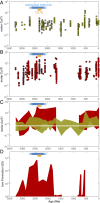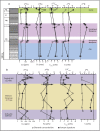Cu isotopes in marine black shales record the Great Oxidation Event
- PMID: 27091980
- PMCID: PMC4983842
- DOI: 10.1073/pnas.1523544113
Cu isotopes in marine black shales record the Great Oxidation Event
Abstract
The oxygenation of the atmosphere ∼2.45-2.32 billion years ago (Ga) is one of the most significant geological events to have affected Earth's redox history. Our understanding of the timing and processes surrounding this key transition is largely dependent on the development of redox-sensitive proxies, many of which remain unexplored. Here we report a shift from negative to positive copper isotopic compositions (δ(65)CuERM-AE633) in organic carbon-rich shales spanning the period 2.66-2.08 Ga. We suggest that, before 2.3 Ga, a muted oxidative supply of weathering-derived copper enriched in (65)Cu, along with the preferential removal of (65)Cu by iron oxides, left seawater and marine biomass depleted in (65)Cu but enriched in (63)Cu. As banded iron formation deposition waned and continentally sourced Cu became more important, biomass sampled a dissolved Cu reservoir that was progressively less fractionated relative to the continental pool. This evolution toward heavy δ(65)Cu values coincides with a shift to negative sedimentary δ(56)Fe values and increased marine sulfate after the Great Oxidation Event (GOE), and is traceable through Phanerozoic shales to modern marine settings, where marine dissolved and sedimentary δ(65)Cu values are universally positive. Our finding of an important shift in sedimentary Cu isotope compositions across the GOE provides new insights into the Precambrian marine cycling of this critical micronutrient, and demonstrates the proxy potential for sedimentary Cu isotope compositions in the study of biogeochemical cycles and oceanic redox balance in the past.
Keywords: Precambrian; Proterozoic; copper cycling; paleoceanography; trace metals.
Conflict of interest statement
The authors declare no conflict of interest.
Figures








References
-
- Bekker A, et al. Dating the rise of atmospheric oxygen. Nature. 2004;427(6970):117–120. - PubMed
-
- Guo Q, et al. Reconstructing Earth’s surface oxidation across the Archean–Proterozoic transition. Geology. 2009;37(5):399–402.
-
- Lyons TW, Reinhard CT, Planavsky NJ. The rise of oxygen in Earth’s early ocean and atmosphere. Nature. 2014;506(7488):307–315. - PubMed
-
- Canfield DE. A new model for Proterozoic ocean chemistry. Nature. 1998;396(6692):450–453.
-
- Konhauser KO, et al. Aerobic bacterial pyrite oxidation and acid rock drainage during the Great Oxidation Event. Nature. 2011;478(7369):369–373. - PubMed
Publication types
LinkOut - more resources
Full Text Sources
Other Literature Sources
Research Materials
Miscellaneous

